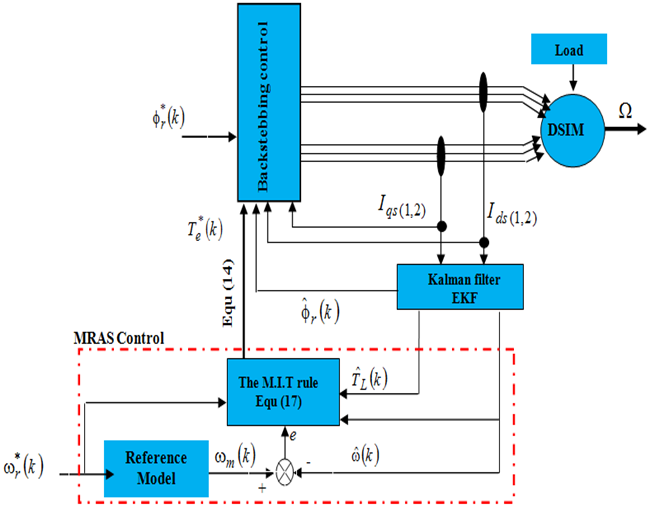Model reference adaptive backstepping control of double star induction machine with extended Kalman sensorless control
DOI:
https://doi.org/10.20998/2074-272X.2022.4.01Keywords:
double stator induction motor, model reference, backstepping control, extended Kalman filterAbstract
Introduction. Newly, the design of a controller for speed control of double star induction motor as a research focus. Consequently, backstepping technique is used to recursively construct a stable control law for speed and flux. Nevertheless, this control law coming from backstepping requires the knowledge of speed and flux values; in practice the measurement sensors are expensive and fragile. The novelty of this work consists to propose a control strategy which based on accurate Kalman filter observer that estimates speed, flux and torque. This extended Kalman filter is an optimal state estimator and is usually applied to a dynamic system that involves a random noise environment. Purpose. Apply a backstepping control of double star induction motor based on principle of rotor flux orientation. This approach consists in finding a Lyapunov function that allows deducing a control law and a modified adaptation rule is referred and sufficient conditions for the stability of the command-observer, in contrast to other techniques who use nonlinear principle. Results. The simulation results are shown to illustrate the performance of the proposed scheme under parametric uncertainties by simulation on MATLAB. The obtained results showed the robustness of the sensorless control in front of load and parameters variation of double stator induction motor. The research directions of the model were determined for the subsequent implementation of results with simulation samples.
References
Hadiouche D., Razik H., Rezzoug A. Study and simulation of space vector PWM control of double-star induction motors. 7th IEEE International Power Electronics Congress. Technical Proceedings. CIEP 2000 (Cat. No.00TH8529), 2000, pp. 42-47. doi: https://doi.org/10.1109/CIEP.2000.891389.
Astrom K.J., Wittenmark B. Adaptive control (2nd Edition). Prentice Hall Publ., 1994.
Parks P. Liapunov redesign of model reference adaptive control systems. IEEE Transactions on Automatic Control, 1966, vol. 11, no. 3, pp. 362-367. doi: https://doi.org/10.1109/TAC.1966.1098361.
Mian A.A., Daobo W. Modeling and Backstepping-based Nonlinear Control Strategy for a 6 DOF Quadrotor Helicopter. Chinese Journal of Aeronautics, 2008, vol. 21, no. 3, pp. 261-268. doi: https://doi.org/10.1016/S1000-9361(08)60034-5.
Bouadi H., Bouchoucha M., Tadjine M. Sliding mode control based on backstepping approach for an UAV type quadrotor. International Journal of Mechanical and Mechatronics Engineering, 2007, vol. 1, no 2, pp. 39-44. doi: https://doi.org/10.5281/zenodo.1077447.
Chaouch S., Nait Said M.S., Makoof A. Backstepping control design of sensorless speed induction motor based on MRAS technique. International Review of Electrical Engineering, 2007, vol. 2, no. 5, pp. 738-744. Available at: https://www.praiseworthyprize.org/latest_issues/IREE-latest/IREE_vol_2_n_5.html#Backstepping_Control_Design_of_Sensorless_Speed_Induction_Motor_Based_on_MRAS_Technique (accessed 10 May 2021).
Benakcha M., Benalia L. Tourqui D., Benakcha A. Backstepping control of dual stator induction generator used in wind energy conversion system. International Journal of Renewable Energy Research, 2018, vol. 8, no. 1, pp. 385-395. doi: https://doi.org/10.20508/ijrer.v8i1.7025.g7313.
Zerdali E., Barut M. Novel version of bi input-extended Kalman filter for speed-sensorless control of induction motors with estimations of rotor and stator resistances, load torque, and inertia. Turkish Journal of Electrical Engineering & Computer Sciences, 2016, vol. 24, pp. 4525-4544. doi: https://doi.org/10.3906/elk-1408-136.
Kuchar M., Brandstetter P., Kaduch M. Sensorless induction motor drive with neural network. 2004 IEEE 35th Annual Power Electronics Specialists Conference (IEEE Cat. No.04CH37551), 2004, vol. 5, pp. 3301-3305. doi: https://doi.org/10.1109/PESC.2004.1355058.
Li J., Xu L., Zhang Z. An Adaptive Sliding-Mode Observer for Induction Motor Sensorless Speed Control. IEEE Transactions on Industry Applications, 2005, vol. 41, no. 4, pp. 1039-1046. doi: https://doi.org/10.1109/TIA.2005.851585.
You J., Wu W., Wang Y. An Adaptive Luenberger Observer for Speed-Sensorless Estimation of Induction Machines. 2018 Annual American Control Conference (ACC), 2018, pp. 307-312. doi: https://doi.org/10.23919/ACC.2018.8431006.
Chaabane H., Khodja D., Chakroune S. Sensorless backstepping control using an Luenberger observer for double star induction motor. Archives of Electrical Engineering, 2020, vol. 69, no. 1, pp. 101-116. doi: https://doi.org/10.24425/aee.2020.131761.
Chaabane H., Khodja D., Chakroune S. Indirect self tuning adaptive control of double stars induction machine by sliding mode. Revue Roumaine Des Sciences Techniques Serie Electrotechnique et Energetique, 2019, vol. 64, no. 4, pp. 409-415. Available at: http://revue.elth.pub.ro/viewpdf.php?id=878 (accessed 10 May 2021).
Bennassar A., Abbou A., Akherraz M., Barara M. Sensorless backstepping control using an adaptive Luenberger observer with three levels NPC inverter. International Journal of Electrical and Computer Engineering, 2013, vol. 7, no. 8, pp. 1171-1177. doi: https://doi.org/10.5281/zenodo.1088970.
Khouidmi H., Massoum A. Reduced-Order Sliding Mode Observer-based Speed Sensorless Vector Control of Double Stator Induction Motor. Acta Polytechnica Hungarica, 2014, vol. 11, no. 6, pp. 229-249. doi: https://doi.org/10.12700/APH.11.06.2014.06.14.
Ameid T., Menacer A., Talhaoui H., Ammar A., Azzoug Y. Sensorless speed estimation and backstepping control of induction motor drive using model reference adaptive system. 2017 5th International Conference on Electrical Engineering - Boumerdes (ICEE-B), 2017, pp. 1-6, doi: https://doi.org/10.1109/ICEE-B.2017.8191977.
Young-Real Kim, S.-K. Sul, Min-Ho Park. Speed sensorless vector control of induction motor using extended Kalman filter. IEEE Transactions on Industry Applications, 1994, vol. 30, no. 5, pp. 1225-1233. doi: https://doi.org/10.1109/28.315233.

Downloads
Published
How to Cite
Issue
Section
License
Copyright (c) 2022 H. Chaabane, D. E. Khodja, S. Chakroune, D. Hadji

This work is licensed under a Creative Commons Attribution-NonCommercial 4.0 International License.
Authors who publish with this journal agree to the following terms:
1. Authors retain copyright and grant the journal right of first publication with the work simultaneously licensed under a Creative Commons Attribution License that allows others to share the work with an acknowledgement of the work's authorship and initial publication in this journal.
2. Authors are able to enter into separate, additional contractual arrangements for the non-exclusive distribution of the journal's published version of the work (e.g., post it to an institutional repository or publish it in a book), with an acknowledgement of its initial publication in this journal.
3. Authors are permitted and encouraged to post their work online (e.g., in institutional repositories or on their website) prior to and during the submission process, as it can lead to productive exchanges, as well as earlier and greater citation of published work.




